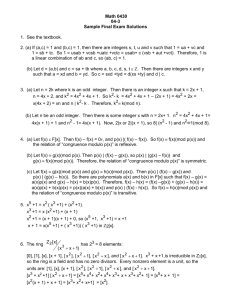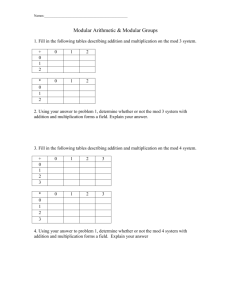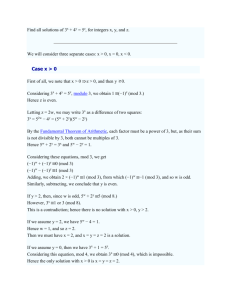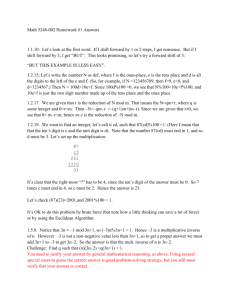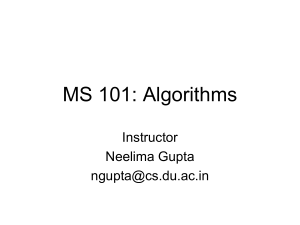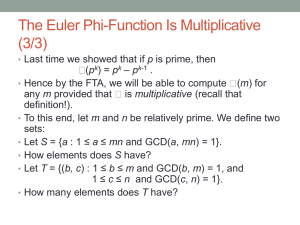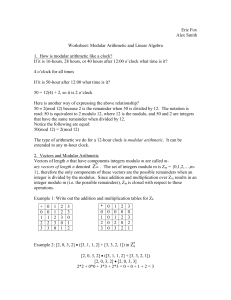finite - SNS Courseware
advertisement
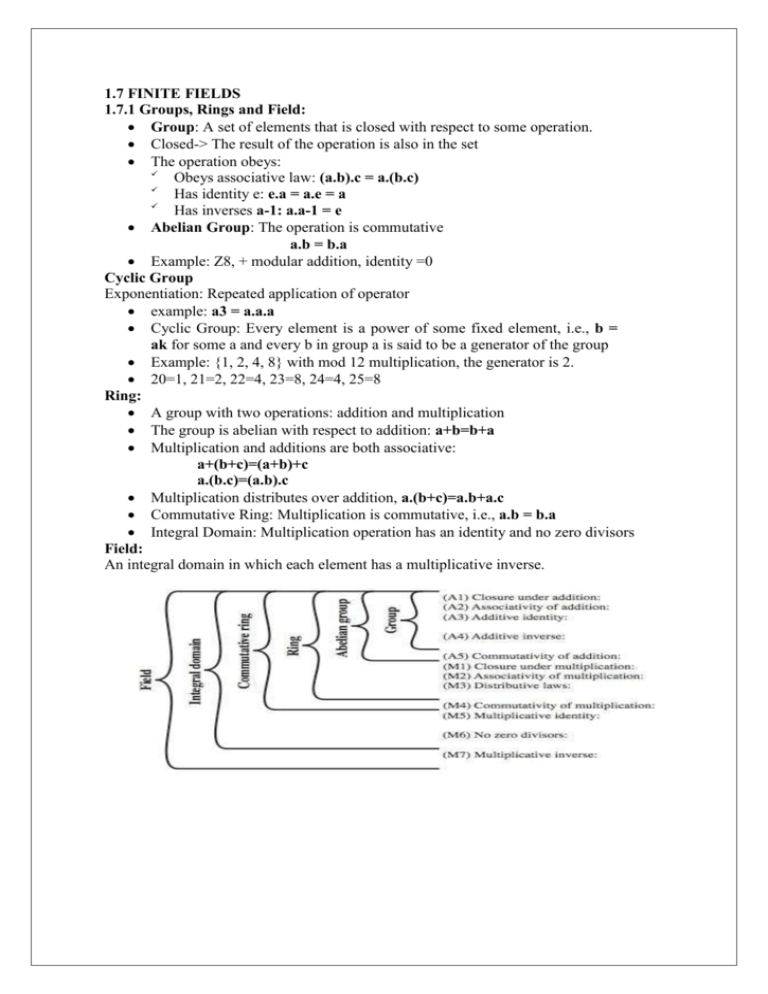
1.7 FINITE FIELDS
1.7.1 Groups, Rings and Field:
Group: A set of elements that is closed with respect to some operation.
Closed-> The result of the operation is also in the set
The operation obeys:
Obeys associative law: (a.b).c = a.(b.c)
Has identity e: e.a = a.e = a
Has inverses a-1: a.a-1 = e
Abelian Group: The operation is commutative
a.b = b.a
Example: Z8, + modular addition, identity =0
Cyclic Group
Exponentiation: Repeated application of operator
example: a3 = a.a.a
Cyclic Group: Every element is a power of some fixed element, i.e., b =
ak for some a and every b in group a is said to be a generator of the group
Example: {1, 2, 4, 8} with mod 12 multiplication, the generator is 2.
20=1, 21=2, 22=4, 23=8, 24=4, 25=8
Ring:
A group with two operations: addition and multiplication
The group is abelian with respect to addition: a+b=b+a
Multiplication and additions are both associative:
a+(b+c)=(a+b)+c
a.(b.c)=(a.b).c
Multiplication distributes over addition, a.(b+c)=a.b+a.c
Commutative Ring: Multiplication is commutative, i.e., a.b = b.a
Integral Domain: Multiplication operation has an identity and no zero divisors
Field:
An integral domain in which each element has a multiplicative inverse.
7.2 Modular Arithmetic
modular arithmetic is 'clock arithmetic'
a congruence a = b mod n says when divided by n that a and b have the same
remainder o 100 = 34 mod 11
o usually have 0<=b<=n-1
o -12mod7 = -5mod7 = 2mod7 = 9mod7
o b is called the residue of a mod n
can do arithmetic with integers modulo n with all results between 0 and n
Addition
a+b mod n
Subtraction
a-b mod n = a+(-b) mod n
Multiplication
a.b mod n
derived from repeated addition
can get a.b=0 where neither
a,b=0 o eg 2.5 mod 10
Division
a/b mod n
-1
is multiplication by inverse of b: a/b = a.b mod n
if n is prime b-1 mod n exists s.t b.b-1 = 1 mod
n o eg 2.3=1 mod 5 hence 4/2=4.3=2 mod 5
integers modulo n with addition and multiplication form a commutative ring with the
laws of
Associativity : (a+b)+c = a+(b+c) mod n
Commutativity : a+b = b+a mod n
Distributivity : (a+b).c = (a.c)+(b.c) mod n
also can chose whether to do an operation and then reduce modulo n, or reduce then
do the operation, since reduction is a homomorphism from the ring of integers to the
ring of integers modulo n
o a+/-b mod n = [a mod n +/- b mod n] mod n o
(the above laws also hold for multiplication)
if n is constrained to be a prime number p then this forms a Galois Field modulo p
denoted GF(p) and all the normal laws associated with integer arithmetic work
Greatest Common Divisor
the greatest common divisor (a,b) of a and b is the largest number that divides evenly into
both a and b
Euclid's Algorithm is used to find the Greatest Common Divisor (GCD) of two numbers
a and n, a<n
o use fact if a and b have divisor d so does a-b, a-2b
GCD (a,n) is given by:
let g0=n
g1=a
gi+1 = gi-1 mod gi when
gi=0 then (a,n) = gi-1
eg find (56,98)
g0=98 g1=56
g2 = 98 mod 56 = 42
g3 = 56 mod 42 = 14
g4 = 42 mod 14 =
0 hence (56,98)=14
Finite Fields or Galois Fields
Finite Field: A field with finite number of elements
Also known as Galois Field
The number of elements is always a power of a prime number. Hence, denoted as GF(pn)
GF(p) is the set of integers {0,1, …, p-1} with arithmetic operations modulo prime p
Can do addition, subtraction, multiplication, and division without leaving the field GF(p)
GF(2) = Mod 2 arithmetic
GF(8) = Mod 8 arithmetic
There is no GF(6) since 6 is not a power of a prime
Polynomial Arithmetic
f(x) = anxn + an-1xn-1 + …+ a1x + a0 = Σ aixi
1. Ordinary polynomial arithmetic:
Add, subtract, multiply, divide polynomials,
Find remainders, quotient.
Some polynomials have no factors and are prime.
2. Polynomial arithmetic with mod p coefficients
3. Polynomial arithmetic with mod p coefficients and mod m(x) operations
Polynomial Arithmetic with Mod 2 Coefficients
All coefficients are 0 or 1, e.g.,
let f(x) = x3 + x2 and g(x) = x2 + x +
1 f(x) + g(x) = x3 + x + 1
f(x) x g(x) = x5 + x2
Polynomial Division: f(x) = q(x) g(x) + r(x)
can interpret r(x) as being a remainder
r(x) = f(x) mod g(x)
if no remainder, say g(x) divides f(x)
if g(x) has no divisors other than itself & 1 say it is irreducible (or prime) polynomial
Arithmetic modulo an irreducible polynomial forms a finite field
Can use Euclid‟s algorithm to find gcd and inverses.

